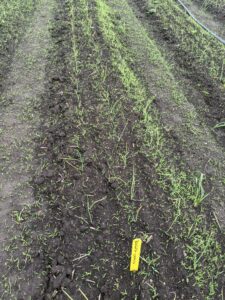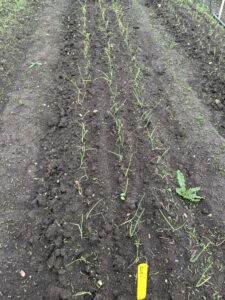Onions are poor competitors with weeds. Their narrow leaves do not compete well for light, and their shallow root system makes them poor competitors for water. Tight in-row and between-row plant spacing make mechanical weed control, including hand-weeding, difficult. Chemical weed control can be effective and reduce the amount of time required to hand-weed onions. However, many small farm operators are reluctant to use herbicides because of potential crop injury, carry-over to subsequent crops, and drift. Others cannot justify the use of herbicides on a small acreage because herbicides are packaged in sizes that greatly exceed small farm needs. Any herbicide used on small farms should have a broad label with documented crop safety for many vegetable crops. It should have limited soil persistence and limited rotational restrictions for vegetable crops grown in rotation on the farm. A few products fit this description, including Dual Magnum®.
Dual Magnum® is labeled nationwide for use in a limited number of vegetable crops for pre-emergence control of annual grasses and small-seed broadleaf weeds. It also provides suppression of yellow nutsedge. In Indiana and numerous other states, Dual Magnum® also has a 24C Special Local Need registration which greatly expands its use to dozens of vegetable and fruit crops, including green onions, bulbing onions, and garlic.
In 2022, the Horticulture Crops Weed Science Lab conducted trials with Dual Magnum® in onions at the Purdue Student Farm. On April 22, ‘Hamilton’ and ‘Venecia’ onions were transplanted into raised beds in a triple-row configuration. Our plots were 10 feet long. One week later, we broadcast-applied 1.3 pints of Dual Magnum per acre over the planted beds. At 4 weeks after transplanting, we applied a grass-selective herbicide, clethodim, with 0.25% non-ionic surfactant to control emerged grasses. Half of the herbicide-treated plots were hand-weeded at 7, 9, and 12 weeks after transplanting. Throughout the study, we rated for weed control and recorded the amount of time required to hand-weed plots. On August 3, we harvested and weighed the onions and weeds in each plot.
Season-long Dual Magnum®-treated plots had 63% weed control. The hand-weeding-only plots required 19.9 minutes/season to remove weeds. Plots receiving a Dual Magnum® application required only 7.2 minutes/season. Onion bulb number and yield was statistically similar in our hand-weeded control plots and those receiving Dual Magnum®. Overall, the net income of the hand-weeded control was $32.09 per plot. Statistically, this was similar to Dual Magnum® followed by hand-weeding ($27.39 per plot) and both treatments were greater than the weedy control ($15.13).
In this study, the application of one pre-emergence herbicide and one application of a grass-selective herbicide reduced hand-weeding labor time by 64% and freed up the farm crew to spend their time on other tasks. Chemical weed control may not be in line with every small farm, but its judicious use can contribute to more efficient crop production- even on a small scale.
For more information on weed control in onions and other vegetable and herb crops, visit the Midwest Vegetable Production Guide at mwveguide.org. To view and download Indiana 24C pesticide labels, visit the Office of the Indiana State Chemist’s website at https://oisc.purdue.edu/pesticide/special_state_registrations.html

